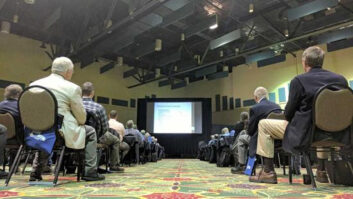Alexander Zink is senior business development manager for Digital Radio and Streaming Applications at Fraunhofer IIS. Stefan Meltzer is technology consultant for Fraunhofer IIS.
The nature of broadcasting entails the benefits of high service reliability as well as a flat-fee transmission cost to serve a virtually unlimited number of concurrent listeners in the target area.

Internet streams of radio programs have become more important in the past decade, but suffer from a cost structure that does not scale well with a growing number of listeners and does not provide the same quality of uninterrupted service as a terrestrial transmission infrastructure. At the same time, broadcasters have been looking for integrated solutions that unify the encoding and service preparation for digital radio services and Internet streaming services.
xHE-AAC FOR ADAPTIVE STREAMING AND DIGITAL RADIO
There are several audio codecs in use for radio broadcasting and streaming that vary significantly in their abilities to provide and maintain reliable audio quality at low bit rates, which may lead to poor sound quality and/or dropouts along with service interruptions when bandwidth is reduced. Previously, especially under these challenging conditions, broadcasters and service providers had to select and prioritize either an audio or a dedicated speech codec, which resulted in poor quality for some signals.

In order to enable consistent high-quality audio at all bit rates for all signal and content types, such as mobile audio and video streaming or digital radio, and to bridge the gap between the separate worlds of audio and speech coding, the audio engineers from Fraunhofer IIS co-developed MPEG xHE-AAC. The xHE-AAC codec, which is equally optimized for speech and music content, eliminates the need for broadcasters to change configuration settings based on the type of audio content.
As the most recent and advanced member of the AAC codec family, xHE-AAC was designed for adaptive streaming and is the only perceptual audio codec that covers the entire bit rate spectrum. The coding efficiency of xHE-AAC allows broadcasters to benefit from a streamlined encoder infrastructure and consistent service quality across all distribution platforms. Consumers can enjoy continuous playback even under challenging network conditions, thanks to the codec’s unparalleled audio quality and dynamic bit rate adaptation feature where player apps can monitor available bandwidth and automatically switch to lower bit rates if needed (as low as 6 kbps per channel).

Once full-bandwidth network connectivity is restored, xHE-AAC seamlessly adapts to the higher bit rates. xHE-AAC possesses the unique capability to switch across the full range of bit rates – from ultra-bitrate-saving up to transparent audio quality.
The ability to deliver good quality even at the lowest bit rates means the xHE-AAC codec can provide billions of 2G network users with streaming services — thus reportedly up to 90 percent of potential streaming users in some emerging markets can now receive reliable service for the first time.
xHE-AAC is also suitable for terrestrial digital radio broadcasting and was adopted as mandatory audio codec by Digital Radio Mondiale. xHE-AAC enables the transmission of multiple stereo programs, along with data services such as Journaline, via a single DRM transmitter within the existing frequency allotments in the AM and FM bands.

Thanks to the new codec, a DRM transmission offers up to three audio stereo services within half the bandwidth of a single analog FM transmission or two audio services on a MW transmission. DRM broadcasters also benefit from a simplified broadcast head-end codec configuration where all audio parameters are automatically optimized internally by the xHE-AAC encoder.
Suitable for both terrestrial broadcasting and streaming, the xHE-AAC technology was recently added to the AAC patent pool administered by Via Licensing at no additional cost to licensees. This can be considered an industry game changer in delivering next-generation audio efficiently and affordably.
MPEG-H 3D AUDIO FOR INTERACTIVE AND IMMERSIVE SOUND
On the other side of the application spectrum, where data bandwidth is typically not an issue, broadcasters are looking for new innovative features to attract a larger audience. A prime example of this is the MPEG-H 3D Audio format, which lets viewers personalize their audio mix and allows broadcasters to transmit a real immersive 3D audio experience in addition to stereo and 5.1 surround sound.
[Read: What do Leading Technologists Want?]
Substantially developed by Fraunhofer IIS, MPEG-H 3D Audio provides broadcasters with new tools, such as object-based audio and ambisonic audio representation, along with additional audio channels.
The MPEG-H Audio format is already part of the ATSC 3.0 and DVB television standards and has been on air in South Korea since May 2017 as the sole audio codec of the first regular terrestrial UHDTV service worldwide. In addition to being integrated in TV broadcast, MPEG-H Audio is suitable for OTT services and can be implemented in smartphones, tablets, soundbars and VR headsets. The codec’s universal delivery feature tailors audio playback to sound best on a wide range of devices and listening environments.
MPEG-H is also on its way to transform streaming services of the future: The EU project Orpheus is exploring possible pathways for future high-end audio-only streaming content, utilizing MPEG-H’s key features for the delivery of interactive and immersive audio.
To see more of the “Trends in Codecs” eBook visit here.












